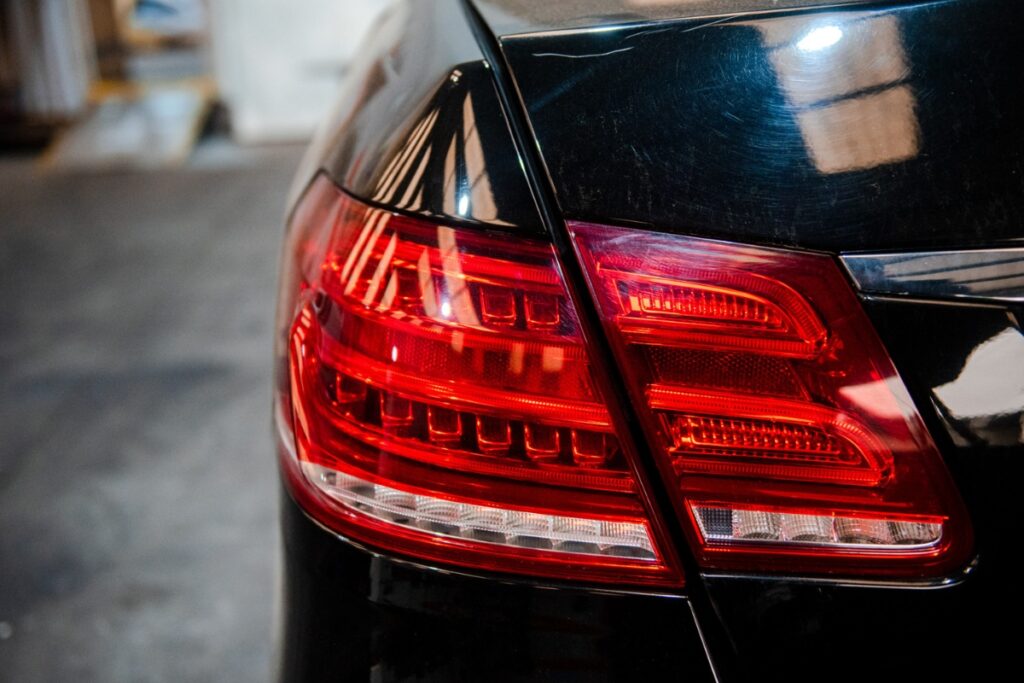When we talk about the importance of lights in the car, we sometimes only focus on the front ones. But the taillights are just as important to ensure the safety of your vehicle.
The purpose of these lights is to illuminate the rear of your car, indicating your position to the drivers behind. Headlights are mainly needed when driving at night or in bad weather (like in the Winter), such as heavy rain, fog or snow.
However, the rear lights can also stop working like any other car part. As well as being dangerous for other drivers, you could still get a fine or fail your car inspection.
So, in this article, discover the main taillight faults and how to change the taillight.
Main taillight problems
Headlight faults can be more complex than a simple bulb change. But there’s no need to worry! We explain.
Get to know the 7 main causes of your car’s taillight failures.
Blown bulb
We start with the most obvious. If the light doesn’t work, then it’s probably fused.
To check it, you will have to remove the bulb from the car and make sure that the wire, which is inside, is broken. This filament is responsible for generating light. If it is damaged, you need to replace the bulb.

Fuse blown
If the bulb is working, we move on to the second most common reason. The fuse. This is the number 1 culprit whenever there is an electrical fault.
Fuses protect the components of the electrical system from receiving power surges. If any of these elements blow, the headlight can receive too much current and break down.
Socket failure
Have you checked the bulb and fuse, and the headlight still doesn’t work?
Then check the condition of the socket. Look for bent or broken pins or discolouration. With corrosion caused by humidity, the socket can become damaged and fail.
Take advantage of this and also check the power supply. If you don’t detect any power in the socket, the wiring may be faulty.
Read also: Engine Control Unit: what is, the features, and possible failures
Deteriorated electrical wiring
Damaged electrical wiring can explain why the fuses are not working and why there isn’t electricity in the socket.
In such cases, you should obtain a wiring diagram and inspect the wiring to find broken, loose or cracked wires.
Control fault
Sometimes the fault may not be directly related to the headlight. The switch on the dashboard can also malfunction, interrupting the connection between the remote and the lights.
Therefore, if the rear brake lights are working and the taillights are not, the remote may have failed.
Dirty or defective light sensor
On the latest car models, the headlight switch has been supplemented with an automatic light sensor. This feature enables the car to switch the lights on and off automatically according to the brightness of the surroundings.
If this sensor breaks down or becomes too dirty, it cannot recognise if it is dark outside, so it may not turn on the headlights. This problem would affect the rear and the front lights. Thus, you can test how well this sensor works by manually turning on the headlights at the switch.
Read also: Alternator: main failures and how to prevent them?
Headlight protection damage
Problems with taillights are not just down to electrical faults. It may be necessary to replace the complete taillight.
For example, the headlights can be damaged in accidents or minor collisions. Also, over time, the headlight cover may become deteriorated, discoloured or opaque. In these cases, it is ideal to change the complete headlight to avoid impairing your car’s visibility at night.

How to change the taillight
As you have seen, taillight malfunctions cannot always be solved with a simple bulb change. You may need to repair some components of your car’s electrical system or even change the taillight.
Driving with dull headlights is just as dangerous as driving with cast headlights. Not only do you put yourself and other drivers at risk, but you could also incur a fine.
To avoid potential problems, we explain how you can change a taillight. It’s more simple than it may sound!
However, please note that on particular car models, the replacement of this part can be more complex. In this case, we use as an example a Mercedes-Benz W212. To change this car taillight, you need a bezel key with ratchet 8 and a screwdriver.
Follow the following steps:
- Start by disconnecting the car battery. Since you will be touching electrical wires, we recommend disconnecting the battery 1 hour before starting this repair.
- Open the boot and remove the side liner near the taillights.
- Disconnect the electric wires by loosening the wiring fittings with the help of the screwdriver.
- Loosen the screws with the bezel key with ratchet 8.
- Gently pull on the taillight to free it from its sockets.
- Remove the old headlight and install the new one into the same sockets.
- Tighten the screws that secure the headlamp to the body with the bezel key with ratchet 8.
- Connect the fittings and connect the electrical cables.
- Place the sidelining inside the case.
- Close the case, connect the battery and confirm that the headlight works.
If you prefer, you can watch the step-by-step video tutorial below.
If in doubt, we recommend you visit a registered garage.
If you are looking for a taillight for your car, you can find over 170,000 on our website for more than 60 brands.

